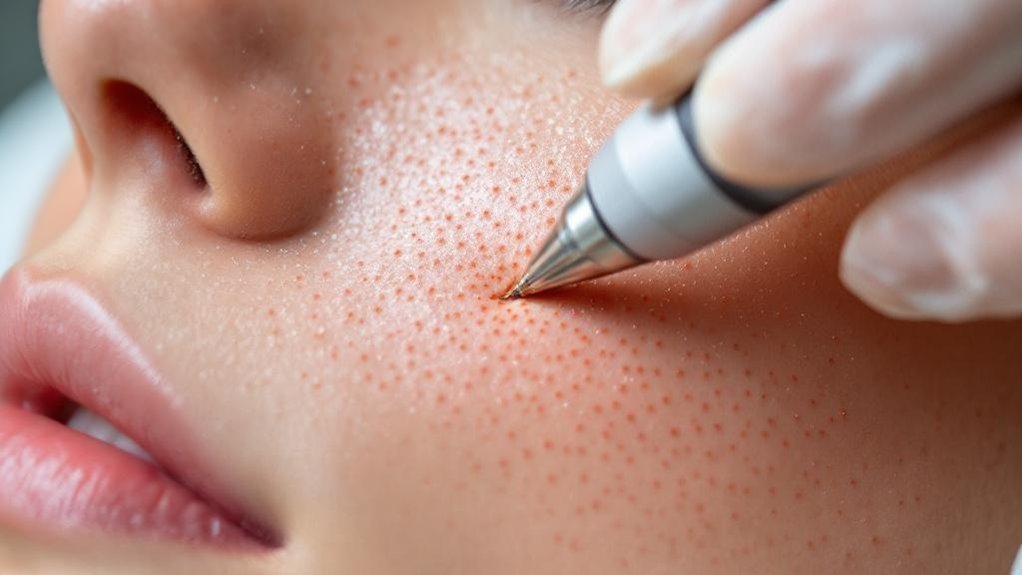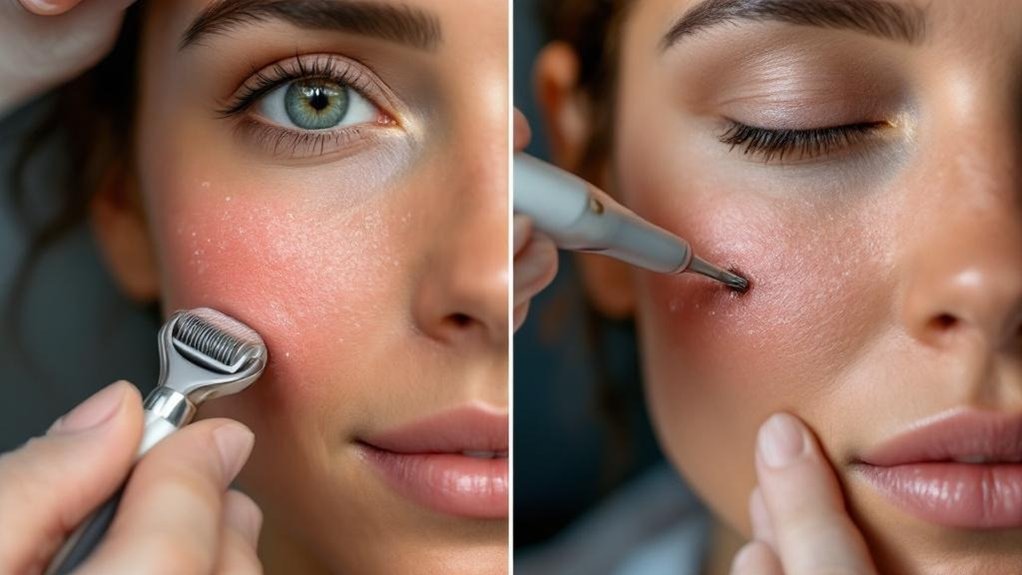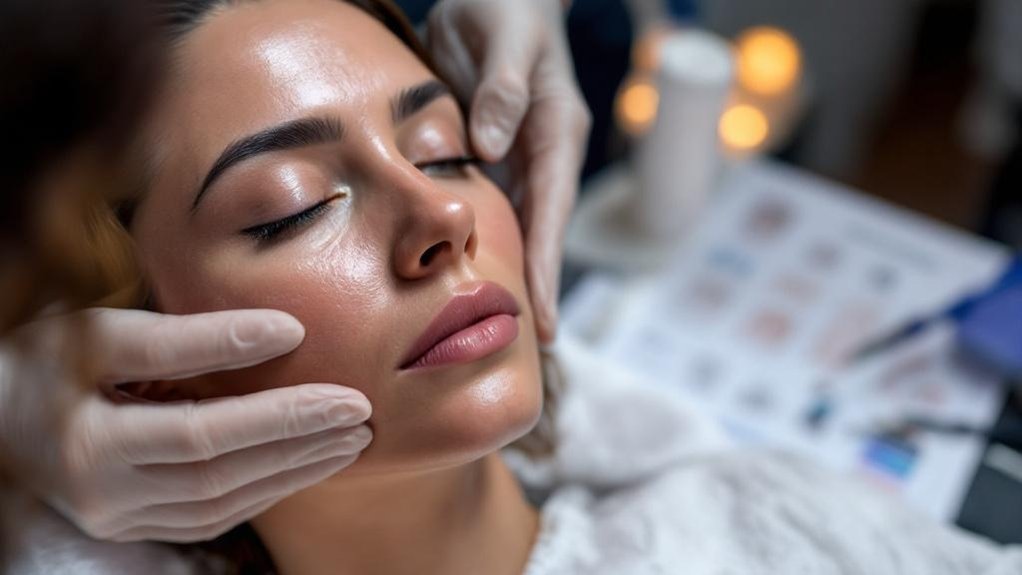Microneedling creates controlled micro-injuries that stimulate the skin’s natural healing response, boosting collagen production. We’ve seen impressive results for acne scars, fine lines, wrinkles, and uneven texture through this minimally invasive procedure. Professional treatments offer deeper penetration with medical-grade equipment, while at-home devices provide milder effects. Post-treatment care includes gentle skincare and strict sun protection. Understanding the full process helps determine if this transformative treatment suits your specific skin concerns.

When patients inquire about microneedling, we’re often asked to explain the science behind this innovative treatment. At its core, microneedling creates controlled micro-injuries to the skin using fine sterile needles. These microscopic punctures trigger the body’s natural wound healing response, stimulating collagen and elastin production.
The efficacy of various microneedling techniques depends on needle depth and treatment protocols. Typically, the procedure activates three phases of skin healing: inflammation, proliferation, and remodeling.
During inflammation, platelets release growth factors that initiate repair. The proliferation phase follows with fibroblast activity generating new collagen. Finally, remodeling occurs as collagen fibers organize and strengthen. This is further enhanced by the application of platelet-rich plasma (PRP), which maximizes the treatment benefits.
This process improves skin texture, reduces scars and fine lines, and enhances overall complexion—all through harnessing your body’s natural regenerative capabilities.
Microneedling offers significant benefits for multiple skin conditions, including reduction of acne scars and active breakouts through collagen stimulation.
We’ve observed remarkable improvements in aging skin, with patients experiencing diminished fine lines, wrinkles, and enhanced skin firmness after treatment.
Our clinical results also demonstrate that microneedling effectively addresses hyperpigmentation issues by promoting cellular turnover and evening out skin tone. Additionally, the procedure is known to stimulate collagen production, leading to further improvements in skin texture and overall appearance.
For individuals struggling with acne and its aftermath, microneedling offers a remarkable solution to improve skin texture and reduce scarring. Our patients with acne scars consistently report significant improvements after treatment. Microneedling works by creating controlled micro-injuries that stimulate collagen production and initiate the skin’s natural healing process. This regeneration helps fill in depressed scars and smooth raised ones.
The treatment effectively addresses various types of acne scarring, including ice pick, boxcar, and rolling scars. We’ve observed that most patients require 3-5 sessions spaced 4-6 weeks apart for ideal results. During your consultation, we’ll assess your specific scarring pattern and develop a customized treatment plan. Throughout the healing process, we’ll guide you with proper aftercare to maximize results while minimizing downtime.
Beyond addressing acne scarring, microneedling has emerged as a powerful anti-aging solution in our dermatological practice.
This minimally invasive procedure effectively targets common signs of aging by creating controlled micro-injuries that trigger collagen stimulation throughout the dermis. We’ve observed remarkable improvements in patients’ fine lines, wrinkles, and overall skin texture after a series of treatments.
The natural skin rejuvenation process activated by microneedling helps restore elasticity and firmness that diminishes with age. Many of our clients appreciate how this procedure addresses multiple concerns simultaneously – reducing pore size, improving skin tone, and enhancing overall facial contour.
For ideal anti-aging results, we typically recommend 3-6 sessions spaced 4-6 weeks apart. The progressive collagen remodeling continues for months after treatment, providing long-lasting rejuvenation without significant downtime.
When treating various forms of hyperpigmentation, we’ve found microneedling to be remarkably effective across diverse skin types and conditions. This procedure stimulates collagen production while creating microchannels that enhance the absorption of topical treatments targeting hyperpigmentation causes like sun damage, melasma, and post-inflammatory marks.
Microneedling effectiveness for hyperpigmentation stems from its ability to accelerate cellular turnover, gradually replacing darkened skin cells with new, evenly-toned ones. Our patients typically notice visible improvement after 3-4 sessions, with continued enhancement as collagen remodeling progresses.
We’ve observed particularly impressive results when combining microneedling with specialized serums containing brightening agents like vitamin C, niacinamide, or tranexamic acid.
This combination therapy addresses both existing discoloration and prevents future hyperpigmentation by strengthening the skin’s protective barriers.
During your microneedling session, our dermatologists will first cleanse your skin thoroughly and apply a topical numbing cream to minimize any discomfort.
This numbing process takes approximately 30 minutes to guarantee ideal patient comfort throughout the procedure. The actual treatment duration typically ranges from 15-30 minutes, depending on the size of the treatment area.
Our specialist will use a medical-grade microneedling device to create controlled micro-injuries across the targeted skin surface. You may feel mild pressure or a slight prickling sensation, but most patients find the experience quite tolerable.
After completing the procedure, we’ll apply a soothing serum and/or mask to calm your skin.
Before you leave, we’ll provide detailed aftercare instructions to enhance your healing process and maximize your results. Additionally, this treatment triggers collagen production, which is crucial for improving the appearance of acne scars over time.

After microneedling, you’ll experience temporary redness that typically subsides within 24-48 hours. This can be managed with recommended calming products from our dermatologists.
We advise avoiding harsh skincare ingredients such as retinoids and alpha-hydroxy acids for at least 5-7 days post-treatment to prevent irritation and maximize healing.
Diligent sun protection with broad-spectrum SPF 30+ is essential during recovery, as your skin will be particularly vulnerable to UV damage that could compromise your treatment results. Additionally, implementing a daily moisturizing routine can enhance skin hydration and support overall recovery.
Managing post-treatment redness is a critical component of your microneedling recovery process. We recommend applying cold compresses for 10-15 minutes every hour during the first 24-48 hours to constrict blood vessels and minimize inflammation.
Your post-treatment skincare should focus on gentle, non-irritating products that support the skin’s natural healing mechanisms.
For effective redness reduction, we suggest products containing calming ingredients like aloe vera, green tea extract, and niacinamide. Avoid direct sun exposure and apply a mineral-based sunscreen with SPF 30+ when outdoors.
Most patients see significant improvement in redness within 2-3 days, though some residual pinkness may persist for up to a week. Remember, this temporary redness indicates your skin’s regenerative process is working—producing the collagen that will ultimately reveal your refreshed complexion.
Proper product selection following microneedling is essential to prevent irritation and optimize healing. We recommend avoiding harsh skincare ingredients for 5-7 days post-procedure, including retinoids, alpha hydroxy acids, beta hydroxy acids, vitamin C, and fragranced products. These can intensify sensitivity and potentially compromise your results. Instead, we suggest gentle product formulations specifically designed for post-treatment care.
Hyaluronic acid serums, ceramide-rich moisturizers, and physical (not chemical) sunscreens are ideal choices during this recovery period. We’ll provide you with a customized list of approved products based on your skin type and concerns.
Sun protection becomes your top priority following microneedling treatment as your skin will be particularly vulnerable to UV damage.
We recommend diligent sunscreen application with a broad-spectrum SPF 30+ product for at least two weeks post-procedure. Apply generously every two hours when outdoors, even on cloudy days. Physical UV protection measures are equally important during this healing phase. We advise wearing wide-brimmed hats and seeking shade whenever possible.
Remember, proper sun protection not only prevents complications like hyperpigmentation but also preserves your microneedling results. Our patients who follow these sun protection protocols consistently report better healing outcomes and longer-lasting results.
If you’re unsure about which sunscreen products are compatible with your newly treated skin, we’re happy to recommend appropriate options for your specific skin type.

When considering microneedling treatments, patients often wonder whether at-home devices or professional treatments would better suit their needs.
At-home tools offer convenience and cost savings but provide considerably less penetration and results than professional treatments. These devices typically feature shorter needles (0.25mm-0.5mm) and require consistent use over longer periods to achieve modest improvements.
Professional microneedling performed at our Skin and Cancer Institute delivers superior results through medical-grade equipment, proper sterilization protocols, and customized treatment plans.
Our dermatologists use needles ranging from 0.5mm-2.5mm depending on your specific concerns and desired outcomes. We believe professional guidance guarantees safety and effectiveness, especially for addressing more considerable skin concerns like acne scarring, deep wrinkles, or stretch marks. Additionally, our commitment to long-term skin health ensures that we provide ongoing support beyond your microneedling sessions. We’re happy to help determine which approach best suits your particular skin needs.
To maximize the benefits of microneedling, our dermatologists frequently combine this procedure with complementary treatments for synergistic results. Common treatment combinations include pairing microneedling with PRP (platelet-rich plasma), hyaluronic acid serums, growth factors, or specialized peptides that can penetrate more deeply through the microchannels created during the procedure.
We’ve found that strategic post-treatment therapies greatly enhance outcomes for specific skin concerns. For instance, combining microneedling with LED light therapy can accelerate healing and reduce inflammation, while adding radiofrequency provides enhanced tightening effects for mature skin. Additionally, incorporating treatments like DiamondGlow Treatment can provide immediate hydration and improve overall skin texture.
Our experts will recommend the ideal combination based on your unique skin needs, creating a customized treatment plan that delivers more thorough results than microneedling alone.

Not everyone is an ideal candidate for microneedling procedures. At Skin and Cancer Institute, we carefully evaluate each patient to determine if this treatment aligns with their skin type and medical history. Ideal candidates typically have mild to moderate skin concerns such as fine lines, acne scars, or uneven texture.
However, several contraindication factors may preclude treatment. These include active skin infections, open wounds, certain skin disorders like psoriasis or eczema, history of keloid scarring, recent Accutane use (within 6 months), pregnancy, and certain autoimmune conditions.
We also exercise caution with patients on blood-thinning medications or those with diabetes. During your consultation, we’ll thoroughly review your medical history to guarantee microneedling is both safe and effective for your specific situation.
We typically see microneedling results duration of 4-6 months, though this varies by individual. With proper skincare, our patients can extend their skin rejuvenation benefits between treatments.
Most patients find the discomfort comparable or less than other cosmetic procedures. We apply topical anesthetics before treatment to minimize any pain. We’ll discuss all treatment options and pain comparison during consultation.
We typically recommend 3-6 sessions spaced 4-6 weeks apart for best outcomes. Your specific needs will determine your session frequency, and we’ll customize a treatment plan for you.
There’s no strict age limit for microneedling. We typically recommend treatments for patients 18+ whose skin concerns would benefit. Ideal age candidates have established skin concerns without significant health contraindications.
Yes, we perform microneedling safely on all skin tones. Our techniques consider specific skin tone variations while maintaining efficacy. We’ll evaluate your unique needs during consultation to guarantee ideal results.
We’ve seen remarkable results from microneedling across diverse skin types and concerns. It’s a scientifically-backed procedure that stimulates your body’s natural healing mechanisms with minimal downtime. Whether you’re addressing acne scars, fine lines, or seeking overall rejuvenation, our team can determine if you’re an ideal candidate. We’ll guide you through every step, ensuring you achieve the most effective, personalized outcome for your skin’s health.